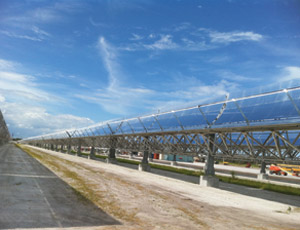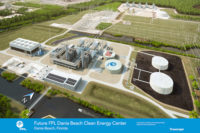Green energy is in; fossil fuels are out. At least that’s the message in the popular press. But if a cutting-edge power project in Florida is any indication, the future may lie not with one or the other but the two working in concert.

Before the end of the year, Florida Power & Light expects to activate what it describes as the world’s first powerplant to integrate concentrated solar power into an existing gas-fired combined-cycle facility in Indiantown, in Martin County in southeastern Florida.
The 75-MW Martin Next Generation Solar Energy Center takes advantage of the best of both fuels. The hybrid plant can run on cheap and clean solar energy when the sun shines with the help of parabolic trough mirrors that concentrate the sun’s radiant power by a factor 80. The energy heats fluid that is converted into steam to move the turbines of the combined cycle unit. On cloudy days, when the sun can’t act as fuel, the combined- cycle unit generates power as it originally was intended to do when it was built in 2003, using readily available natural gas.
Using two fuels in one plant is not new; in fact, switching between oil and gas is a fairly common way to take advantage of best price and fuel availability. What is new is the growing use of renewable energy as the companion fuel.
Biomass has taken the lead, operating in combination with coal, particularly in Europe. But growing interest exists in solar hybrid plants, the choice of not only FP&L but also Italian utility Enel, which recently unveiled its own solar-gas hybrid, a 5-MW plant that uses molten salts to store the solar heat. Other hybrids pair solar with coal, such as the Cameo Generating Station built by Colorado utility Xcel Energy.
Still, the solar hybrid technology is so new, construction and design presented some unexpected challenges for FP&L, which contracted with Abilene, Texas-based Lauren Engineers & Constructors for engineering and procurement as well as construction.
“It is a lot more complicated than people think. … It was 1.9-million man- hours of construction,” says John Gnecco, FP&L director of development.
For one thing, Florida has weather problems not found in deserts where combined-solar powerplants typically are built. FP&L feared the wing-shaped mirrors might take flight under 150 miles per hour winds.
“It has 190,000 mirrors. If they start breaking, it is lot of bad luck, man—seven years a mirror,” Gnecco said
To solve the problem, FP&L used tempered glass—produced in Spain by Rio Glass Solar—seated with extra bolts within framing made from recycled Florida aluminum. Built on a truss system, the units rotate and follow the sun from east to west as it traverses the sky. The final result is massive, covering 500 acres, or 51 miles if you walk row by row.
The solar plant is on track to come in 20% below its $476.3-million budget, an achievement Gnecco attributes to economies of scale and assembly-line efficiency. The aluminum frames, for example, arrived in pieces that were assembled by 1,000 workers on the site. “When we started, it took four to six hours to build a frame. By the time we were done, it took less than 30 minutes,” he said.
The solar project is drawing international attention, and FP&L finds itself leading tours for the U.S. Dept. of State. The utility hopes to build more such projects, but much depends on the willingness of state lawmakers to let the utility again recover costs in rates. So far that has not happened, but Gnecco remains hopeful. “There is a tremendous amount of interest in this project; it is a showcase project. I’ve got to tell you, I’ve been building powerplants for 20 yearss, and this is the best of them,” he says.
“We are in discussions with several western and Southeast utilities that are considering these types of projects,” said Clint Rosenbaum, Lauren vice president of engineering. Hybrid plants cut capital costs for utilities, he adds. “Savings could also be realized from reduced CO? with some form of carbon credits. … Hybrid powerplants are the near-term future for concentrating solar power,” he says.


Post a comment to this article
Report Abusive Comment